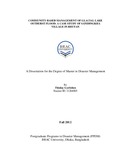Community-based management of Glacial Lake outburst flood : a case study of Samdingkha village in Bhutan

View/Open
Date
2012Publisher
BRAC UniversityAuthor
Gyeltshen, ThinlayMetadata
Show full item recordAbstract
Climate change is contributing to increased melting of glaciers and formation of
glacial lakes. The threat of Glacial Lake Outburst Floods (GLOF) is posing a serious
threat to the lives and livelihoods of the Bhutanese people. The melting of glaciers is
leading to alarming volumes of water in downstream glacial lakes. Increased temperature
also causes melting of ice-cored moraine dams to the point that the ridges can no longer
resist the pressure. The concern is that when the current holding capacity of the lakes
reaches a critical threshold, loose glacial debris that act as dams or barriers could fail and
lead to flash floods. This phenomenon results in severe adverse impacts on downstream
communities.
A large number of communities in the Punakha Valley are vulnerable to GLOF
from Glacier Lake at sources of Pho Chu. The risk of damage to their agricultural fields,
washing away critical infrastructures, killing of cattle and even losing lives has increase
in recent years. Further increased glacial melting and GLOF will have devastating effects
on the hydropower plants in the country. Hydropower, which accounts for a significant
portion of the country’s revenue involves huge investments in infrastructure and requires
sustainable water resources.
The study is focused in assessing the Livelihood capital and Vulnerability of
people living along the Pho Chu in Samdingkha Village. Field data were collected from
Samdingkha village as part of the case study. The information was collected through
participatory tools and further followed by DIFDs livelihood analysis guidelines and
Expand – Contract Model. To assess the information, literature were reviewed from
different journals, books, government policies, meteorological and hydrological data and
other unpublished thesis work and articles.
